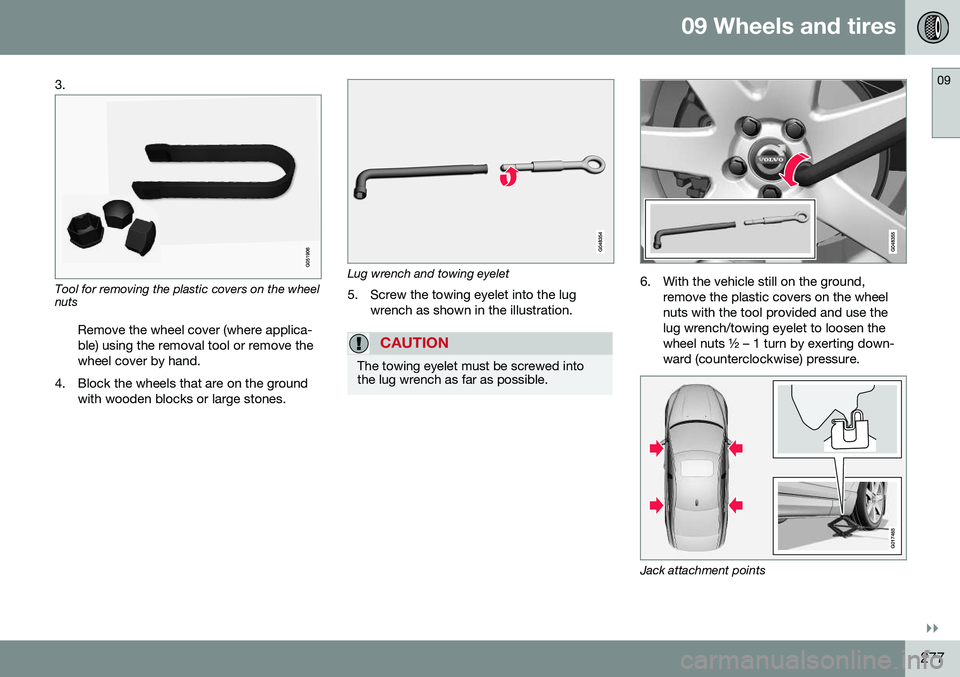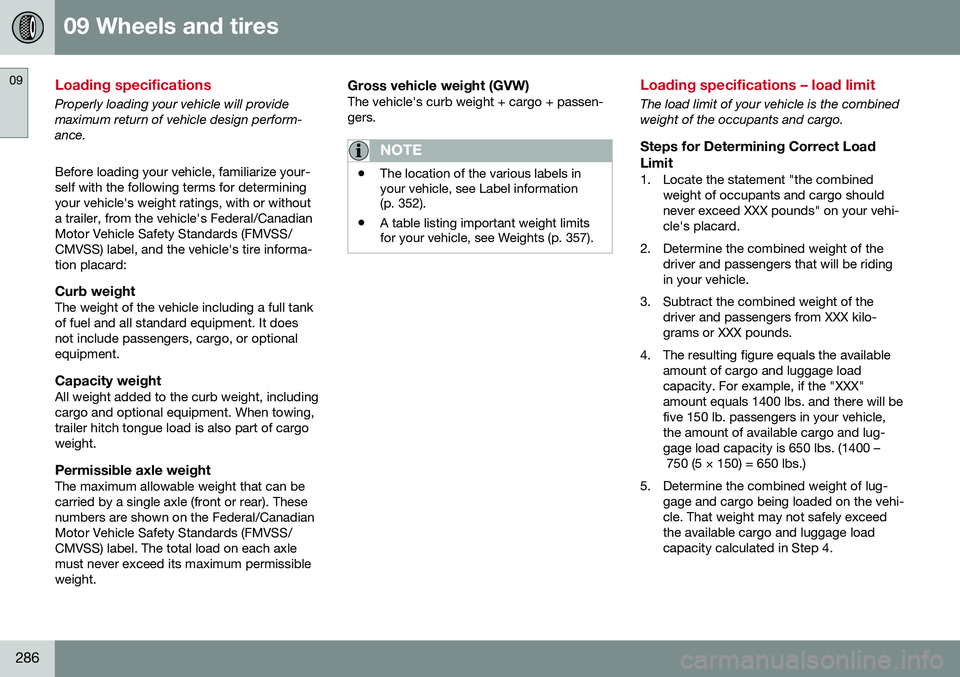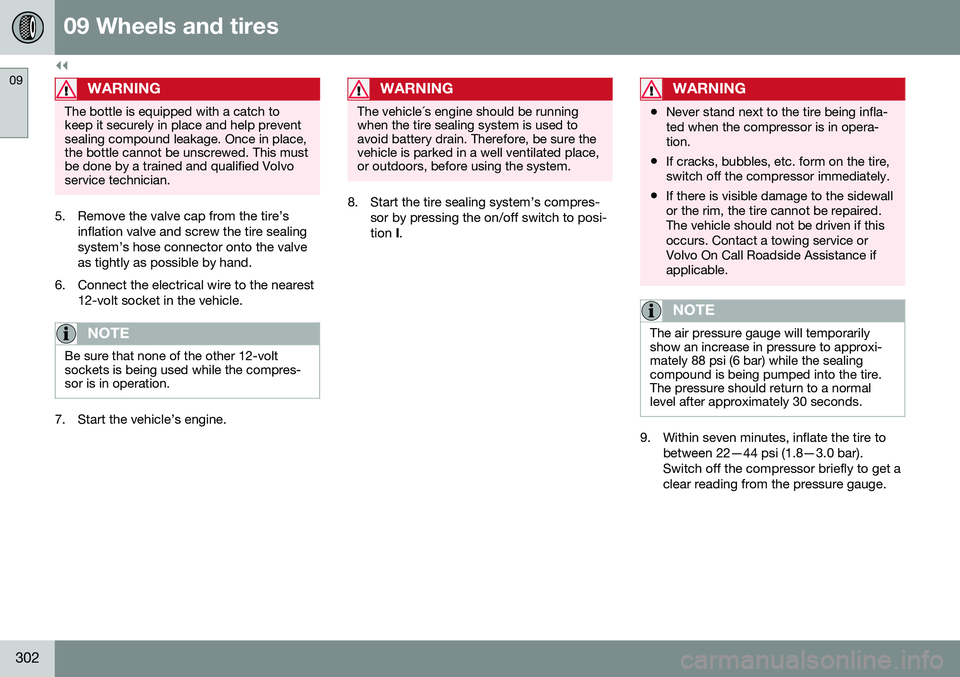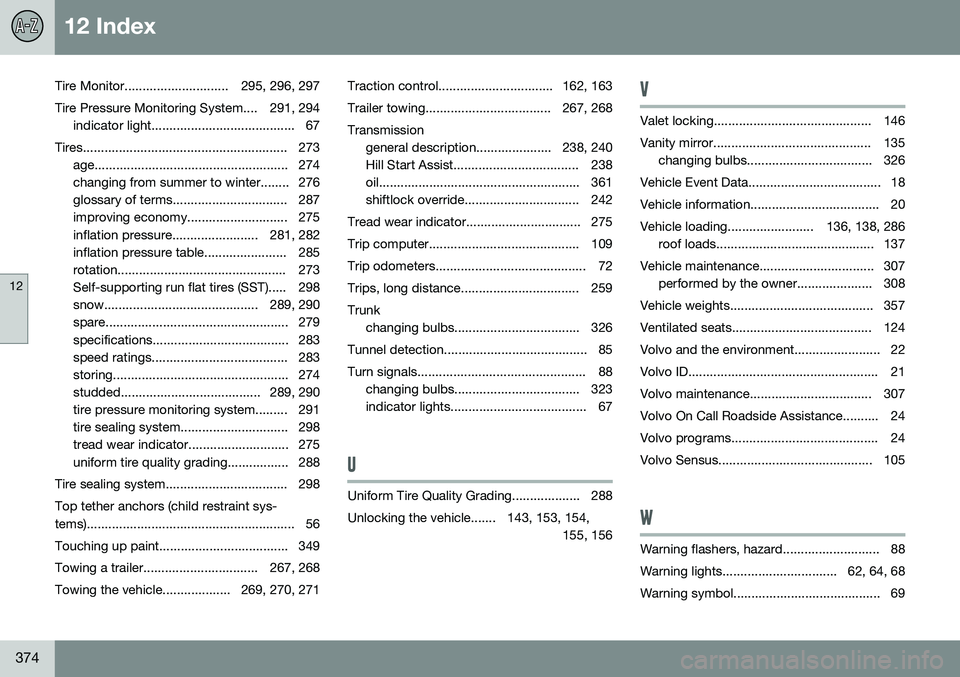2016 VOLVO S80 towing
[x] Cancel search: towingPage 279 of 380

09 Wheels and tires
09
}}
277
3.
Tool for removing the plastic covers on the wheel nuts
Remove the wheel cover (where applica- ble) using the removal tool or remove thewheel cover by hand.
4. Block the wheels that are on the ground with wooden blocks or large stones.Lug wrench and towing eyelet
5. Screw the towing eyelet into the lug wrench as shown in the illustration.
CAUTION
The towing eyelet must be screwed into the lug wrench as far as possible.
6. With the vehicle still on the ground,remove the plastic covers on the wheel nuts with the tool provided and use thelug wrench/towing eyelet to loosen thewheel nuts ½ – 1 turn by exerting down-ward (counterclockwise) pressure.
G017465
Jack attachment points
Page 288 of 380

09 Wheels and tires
09
286
Loading specifications
Properly loading your vehicle will provide maximum return of vehicle design perform-ance. Before loading your vehicle, familiarize your- self with the following terms for determiningyour vehicle's weight ratings, with or withouta trailer, from the vehicle's Federal/CanadianMotor Vehicle Safety Standards (FMVSS/CMVSS) label, and the vehicle's tire informa-tion placard:
Curb weightThe weight of the vehicle including a full tankof fuel and all standard equipment. It doesnot include passengers, cargo, or optionalequipment.
Capacity weightAll weight added to the curb weight, includingcargo and optional equipment. When towing,trailer hitch tongue load is also part of cargoweight.
Permissible axle weightThe maximum allowable weight that can becarried by a single axle (front or rear). Thesenumbers are shown on the Federal/CanadianMotor Vehicle Safety Standards (FMVSS/CMVSS) label. The total load on each axlemust never exceed its maximum permissibleweight.
Gross vehicle weight (GVW)The vehicle's curb weight + cargo + passen-gers.
NOTE
•The location of the various labels in your vehicle, see Label information(p. 352).
• A table listing important weight limitsfor your vehicle, see Weights (p. 357).
Loading specifications – load limit
The load limit of your vehicle is the combined weight of the occupants and cargo.
Steps for Determining Correct Load
Limit
1. Locate the statement "the combined weight of occupants and cargo shouldnever exceed XXX pounds" on your vehi-cle's placard.
2. Determine the combined weight of the driver and passengers that will be ridingin your vehicle.
3. Subtract the combined weight of the driver and passengers from XXX kilo-grams or XXX pounds.
4. The resulting figure equals the available amount of cargo and luggage loadcapacity. For example, if the "XXX"amount equals 1400 lbs. and there will befive 150 lb. passengers in your vehicle,the amount of available cargo and lug-gage load capacity is 650 lbs. (1400 – 750 (5 × 150) = 650 lbs.)
5. Determine the combined weight of lug- gage and cargo being loaded on the vehi-cle. That weight may not safely exceedthe available cargo and luggage loadcapacity calculated in Step 4.
Page 289 of 380

09 Wheels and tires
09
}}
287
6. If your vehicle will be towing a trailer, load
from your trailer will be transferred to your vehicle.
WARNING
•Exceeding the permissible axle weight, gross vehicle weight, or any otherweight rating limits can cause tireoverheating resulting in permanentdeformation or catastrophic failure.
• Do not use replacement tires withlower load carrying capacities than thetires that were original equipment onthe vehicle because this will lower thevehicle's GVW rating. Use only tireswith the correct load carrying capacity.Consult your Volvo retailer for informa-tion.
Tire specifications – terminology
The following is a glossary of tire-related terms. The tire suppliers may have additional mark- ings, notes or warnings such as standardload, radial tubeless, etc.
• Tire information placard
: A placard
showing the OE (Original Equipment) tire sizes, recommended inflation pressure,and the maximum weight the vehicle cancarry.
• Tire Identification Number (TIN)
: A
number on the sidewall of each tire pro-viding information about the tire brandand manufacturing plant, tire size anddate of manufacturer.
• Inflation pressure
: A measure of the
amount of air in a tire.
• Standard load
: A class of P-metric or
Metric tires designed to carry a maximumload at 35 psi [37 psi (2.5 bar) for Metrictires]. Increasing the inflation pressurebeyond this pressure will not increase thetires load carrying capability.
• Extra load
: A class of P-metric or Metric
tires designed to carry a heavier maxi-mum load at 41 psi [43 psi (2.9 bar) forMetric tires]. Increasing the inflation pres-sure beyond this pressure will notincrease the tire's load carrying capabil-ity. •
kPa
: Kilopascal, a metric unit of air pres-
sure.
• PSI
: Pounds per square inch, a standard
unit of air pressure.
• B-pillar
: The structural member at the
side of the vehicle behind the front door.
• Bead area of the tire
: Area of the tire
next to the rim.
• Sidewall of the tire
: Area between the
bead area and the tread.
• Tread area of the tire
: Area of the perim-
eter of the tire that contacts the roadwhen mounted on the vehicle.
• Rim
: The metal support (wheel) for a tire
or a tire and tube assembly upon whichthe tire beads are seated.
• Maximum load rating
: a figure indicating
the maximum load in pounds and kilo-grams that can be carried by the tire. Thisrating is established by the tire manufac-turer.
• Maximum permissible inflation pressure
: the greatest amount of air
pressure that should ever be put in the tire. This limit is set by the tire manufac-turer.
• Recommended tire inflation pressure
:
inflation pressure, established by Volvo,which is based on the type of tires thatare mounted on a vehicle at the factory.This information can be found on the tireinflation placard(s) located on the driver's
Page 304 of 380

||
09 Wheels and tires
09
302
WARNING
The bottle is equipped with a catch to keep it securely in place and help preventsealing compound leakage. Once in place,the bottle cannot be unscrewed. This mustbe done by a trained and qualified Volvoservice technician.
5. Remove the valve cap from the tire’sinflation valve and screw the tire sealing system’s hose connector onto the valveas tightly as possible by hand.
6. Connect the electrical wire to the nearest 12-volt socket in the vehicle.
NOTE
Be sure that none of the other 12-volt sockets is being used while the compres-sor is in operation.
7. Start the vehicle’s engine.
WARNING
The vehicle´s engine should be running when the tire sealing system is used toavoid battery drain. Therefore, be sure thevehicle is parked in a well ventilated place,or outdoors, before using the system.
8. Start the tire sealing system’s compres-sor by pressing the on/off switch to posi- tion I.
WARNING
• Never stand next to the tire being infla- ted when the compressor is in opera-tion.
• If cracks, bubbles, etc. form on the tire,switch off the compressor immediately.
• If there is visible damage to the sidewallor the rim, the tire cannot be repaired.The vehicle should not be driven if thisoccurs. Contact a towing service orVolvo On Call Roadside Assistance ifapplicable.
NOTE
The air pressure gauge will temporarily show an increase in pressure to approxi-mately 88 psi (6 bar) while the sealingcompound is being pumped into the tire.The pressure should return to a normallevel after approximately 30 seconds.
9. Within seven minutes, inflate the tire to
between 22—44 psi (1.8—3.0 bar). Switch off the compressor briefly to get aclear reading from the pressure gauge.
Page 371 of 380

12 Index
12
369
ISOFIX/LATCH anchors........................ 54
top tether anchors................................ 56
Child safety................................................ 45 booster cushions.................................. 53
child restraint systems.......................... 47
convertible seats.................................. 51
infant seats........................................... 49
Child safety locks...................................... 57
City safety........................................ 189, 190
Climate system........................................ 126 air distribution..................... 121, 127, 129
air vents.............................................. 121
Interior Air Quality System.................. 119
introduction......................................... 118
passenger compartment filter............ 119
refrigerant........................................... 118
Clock, setting............................................. 72
Cold weather driving................................ 260
Collision warning system.. 196, 198, 201, 202, 204, 205
Compass in rearview mirror....................... 99
Connected service booking..................... 310
Conserving electrical current................... 259
Convertible seats....................................... 51
Coolant............................................ 316, 361
Cooling system, general information....... 259
Courtesy lighting........................................ 89 Crash event data....................................... 18
Crash mode......................................... 44, 45
Cruise control.................................. 168, 170
adaptive.............................................. 171
Curb weight............................................. 286
Current, conserving................................. 259
Cyclist detection.............................. 200, 204
D
Daytime running lights............................... 82
Defroster.................................................. 126
Detachable key blade...................... 145, 146Disconnecting the front passenger’s air-
bag............................................................. 36
Distance Alert.......................................... 185
Dome lighting............................................. 89
Door mirrors......................................... 96, 97
Driver alert....................... 209, 210, 211, 212 Lane Departure Warning..... 214, 216, 217
Driver distraction warning.......................... 23
Driving economically................................ 265
Driving in cold weather............................ 260
Driving through water.............................. 258
E
ECC......................................... 123, 124, 125
Eco (driving function)............................... 248
Eco coast................................................. 248
Eco guide................................................... 65
Economical driving.................................. 265
Electrically heated steering wheel............. 82
Electrical sockets..................................... 134
Electric parking brake.............. 254, 255, 257
Electronic Climate Control............... 122, 125 air distribution table............................ 129
Interior Air Quality System.................. 120
ventilated seats................................... 124
Electronic oil level sensor........................ 315
Electronic stability control....................... 162
Emergency locking retractor...................... 47
Emergency starting.................................. 237
Emergency towing................... 269, 270, 271
Emission inspection readiness................ 310Engine overheating........................................... 69
specifications...................................... 358
Start/Stop........... 243, 244, 245, 246, 247
starting................................................ 233
switching off............................... 235, 236
Page 376 of 380

12 Index
12
374
Tire Monitor............................. 295, 296, 297Tire Pressure Monitoring System.... 291, 294 indicator light........................................ 67
Tires......................................................... 273 age...................................................... 274
changing from summer to winter........ 276
glossary of terms................................ 287
improving economy............................ 275
inflation pressure........................ 281, 282
inflation pressure table....................... 285
rotation............................................... 273
Self-supporting run flat tires (SST)..... 298
snow........................................... 289, 290
spare................................................... 279
specifications...................................... 283
speed ratings...................................... 283
storing................................................. 274
studded....................................... 289, 290
tire pressure monitoring system......... 291
tire sealing system.............................. 298
tread wear indicator............................ 275
uniform tire quality grading................. 288
Tire sealing system.................................. 298 Top tether anchors (child restraint sys-
tems).......................................................... 56
Touching up paint.................................... 349
Towing a trailer................................ 267, 268
Towing the vehicle................... 269, 270, 271 Traction control................................ 162, 163
Trailer towing................................... 267, 268Transmission
general description..................... 238, 240
Hill Start Assist................................... 238
oil........................................................ 361
shiftlock override................................ 242
Tread wear indicator................................ 275
Trip computer.......................................... 109
Trip odometers.......................................... 72
Trips, long distance................................. 259Trunk changing bulbs................................... 326
Tunnel detection........................................ 85
Turn signals............................................... 88 changing bulbs................................... 323
indicator lights...................................... 67
U
Uniform Tire Quality Grading................... 288
Unlocking the vehicle....... 143, 153, 154, 155, 156
V
Valet locking............................................ 146
Vanity mirror............................................ 135changing bulbs................................... 326
Vehicle Event Data..................................... 18
Vehicle information.................................... 20
Vehicle loading........................ 136, 138, 286 roof loads............................................ 137
Vehicle maintenance................................ 307 performed by the owner..................... 308
Vehicle weights........................................ 357
Ventilated seats....................................... 124
Volvo and the environment........................ 22
Volvo ID..................................................... 21
Volvo maintenance.................................. 307
Volvo On Call Roadside Assistance.......... 24
Volvo programs......................................... 24
Volvo Sensus........................................... 105
W
Warning flashers, hazard........................... 88
Warning lights................................ 62, 64, 68
Warning symbol......................................... 69